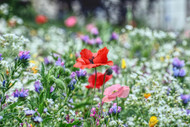100% Wildflower Seed Sowing & Maintenance
THE BLOOM OF WILDFLOWERS IN THE FIRST FEW SEASONS WILL BE HEAVILY DEPENDANT ON SOIL CONDITIONS, WEATHER AND LEVELS OF MAINTENANCE. PLEASE NOTE A FULL WILDFLOWER DISPLAY MAY TAKE A NUMBER OF SEASONS TO ESTABLISH.
Preparation
Remove any existing weeds or vegetation growth. Over-turn the top layer of soil to aerate, be careful not to dig down too deep as this may activate existing dormant seeds in the soil. After two weeks any additional weeds or vegetation will have appeared, remove as before and again over-turn the top layer of soil. If time allows, repeat this process until you are confident all weeds have been removed from the soil. The area can now be sown with your chosen wildflower mix.
Sowing Period
It is recommended that wildflower seeds are sown in Autumn or Spring. Autumn-sown mixes will show higher diversity of germination in the first Spring, as the harder seed shells are softened throughout Winter by the regular freeze/defrost action. Spring-sown mixes will have a lower germination in the first year, but after the first Winter, more species will start to germinate.
100% Wildflower Mixes
Sowing
Standard sowing rates for 100% wildflower mixes is 2-3g/m2. Ground preparation and sowing periods are detailed above. After the seed mix is sown, press down the seed into the soil to ensure good contact and germination. THE SEED SHOULD SIT AT/NEAR THE SOIL SURFACE AND SHOULDN’T BE BURIED. A roller can be used on large areas, or simply tread-in on smaller jobs.
Year 1 Maintenance
For grass and wildflower mixes it is important that the newly-sown area is cut back every 3-4 weeks to a height of 75-100mm in year 1. This will keep grasses under control and enable the wildflowers to establish a root structure. Any clippings should be collected and removed after each cut to prevent mulching down. PLEASE NOTE WITH GRASS AND WILDFLOWER MIXES THERE IS LITTLE OR NO FLOWERING IN YEAR 1.
Subsequent years will show a more balanced mix of wildflowers and grasses. In late-Summer or early-Autumn, a final cut should be made and the arisings removed. If any wildflowers have flowered and developed seed heads at this stage, the clippings may be left in situ for a few days in order to allow seeds to drop, in order to establish and enhance future year’s wildflowers on the site. Leaving the clippings will also allow any wildlife to clear the area before being taken away.
Year 2 and Subsequent Years’ Maintenance
From Year 2 onwards, the wildflower area can be allowed to grow unchecked throughout the growing season, as the wildflowers should now be strong enough to cope with some competition from grasses. Should the area require a ‘tidy’ a cut may be carried out in early-Spring before the start of the proper growing season, in order just to ‘tidy’ things up a little, but this isn’t a necessary action. After flowering and after seed heads have dispersed, a final cut of the year should be undertaken. You may wish to leave the clippings for a few days before collecting, to allow any final seeds to fall.

